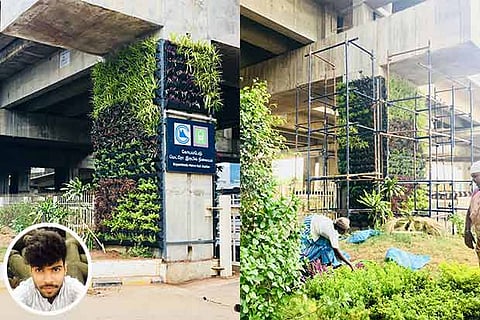

Chennai
Three years ago, Niranjan Sharma began to wonder if he could make plastic granules out of PET bottles — there were people already doing so at that point, so he decided to bring about something unique.
He realised that a huge portion of Chennai’s population lives in apartments, where there is a lack of ground space to keep pots and plants. So since most household items right from TVs to fans can be wall-mounted, he figured out why not pots or plant holders.
“Moreover, in cases of those who had plants in their balconies, the runaway soil after a plant is watered damages the tiles and leaves the floor dirty. So another feature I wanted to include was a system whereby the excess water could flow directly into the drainage without seeping onto the floor,” says the 27-year-old director of his company, Grego Recycling Pvt. Ltd.
In order to research these avenues further, he attended a skill-development course on plastic in Central Institute of Plastics Engineering and Technology (CIPET) and got to know there are seven types of plastics that could be recycled.
“I wanted to convert waste into something meaningful, so I zeroed in on products made from Polypropylene (PP) that can be found in any
household’s trash.”
Since the design with the specifications he mentioned above wasn’t available in any other market, he decided to patent the planters under the name Festoon, and today, they are completely made in India. Each planter lasts for five years and can be recycled thrice, but each time, new waste material has to be added.
The plants come equipped with a drip-irrigation system — “An entire vertical garden would require eight litres of water in a day, so this system ensures only so much water is released,” says Niranjan. “Water doesn’t have to be ‘poured’ manually on the plants, thereby reducing wastage to only five per cent,” he adds.
Festoon planters have been used to create a vertical garden in Koyambedu’s Central Metro Rail Station.
“I’d seen such greenery projects in Bengaluru and Koch metros; I met up with the officials and found out the pros and cons from them, he notes. Once I knew I had solutions for all the disadvantages, I approached the Chennai management. They told me not to damage the pillars in terms of drilling or water seepage but were open to the idea,” explains Niranjan.
A mix of air-purifying and ornamental species like spider plant, asparagus, rain lily, red and gold durantas and table roses was installed over a period of 30 days by his team with the help of CMRL civil engineers.
“Since this pilot project is a success, there are 80 more pillars on which the installations need to be done but priority will be given to the ones that are exposed to the most to pollution, especially if they’re located near traffic signals or important junctions,” he concludes.
Visit news.dtnext.in to explore our interactive epaper!
Download the DT Next app for more exciting features!
Click here for iOS
Click here for Android